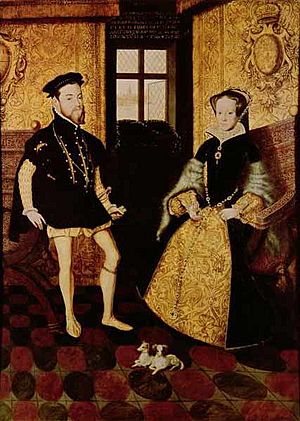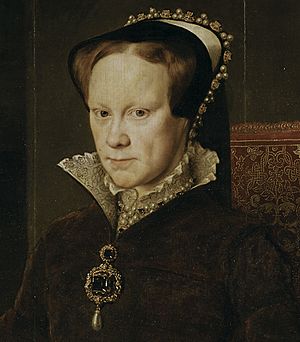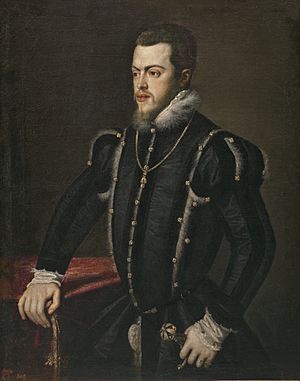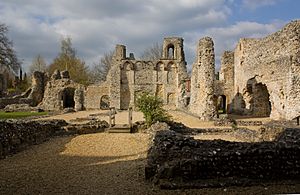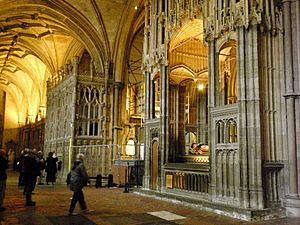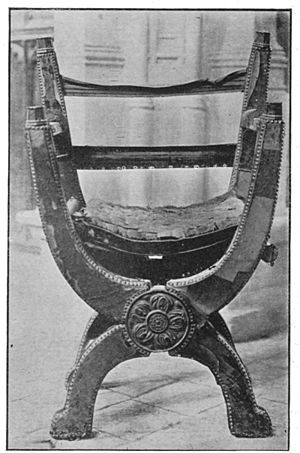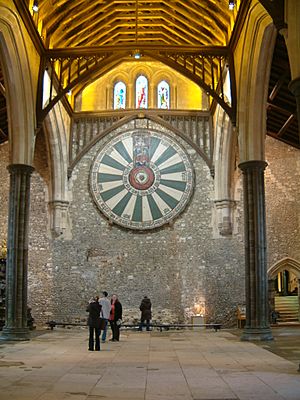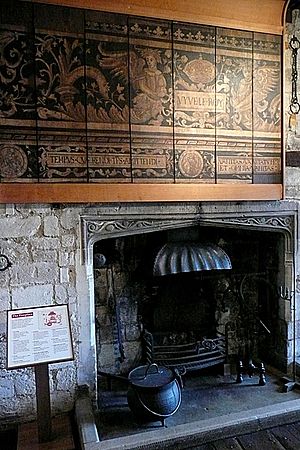Wedding of Mary I of England and Philip of Spain facts for kids
Mary I of England (born 1516, died 1558) and Philip of Spain (born 1527, died 1598) got married at Winchester Cathedral on Wednesday, July 25, 1554.
Contents
Planning the Royal Wedding
Many people in England did not want their new Queen to marry a foreign prince. Some Spanish writers noted that the English people were wary of foreigners. Even a bishop named Antoine Perrenot de Granvelle thought the English would find the marriage very difficult to accept. However, not everyone felt this way, especially in cities like London where many people from other countries lived and worked. Some of Mary's own advisors were against the marriage.
In November, Mary of Hungary, who governed the Netherlands, sent a painting of Philip to Mary. This was important because Mary had not yet met her future husband. The painting, made by the famous artist Titian, showed Philip wearing a wolfskin.
Some people who opposed the marriage, led by Thomas Wyatt the Younger, started a rebellion against Queen Mary. Wyatt brought his army to London in February 1554. Queen Mary gave a powerful speech in London's Guildhall. She told everyone that her coronation ring meant she was "wedded to the realm and law" of England. Wyatt eventually gave up. Sadly, Lady Jane Grey, a Protestant leader, was executed on February 12, and Wyatt on April 11.
The English Parliament passed a law in April 1554 called the Act for the Marriage of Queen Mary to Philip of Spain. This law allowed the marriage to happen. It also set Mary's dowry (money or property brought by a bride to her marriage). The marriage agreement also said that Philip could not change England's old laws or customs. It also made it clear that if Mary died without children, Philip would have no special rights to the English throne.
Philip's Journey to England
A Spanish nobleman, Pedro Dávila y Zúñiga, arrived in England in June. He was met by the Earl of Pembroke. Pedro Dávila traveled through the countryside, enjoying activities like hare coursing (a type of hunting). He brought a gift for Mary from Philip: a diamond jewel. Mary later wore this diamond and a ruby on her wedding day.
Philip left Spain on July 12, 1554. He sailed on a ship called the Espíritu Santo. His fleet was protected by 31 English ships. Mary went to wait at the Palace in Bishop's Waltham. She heard that Philip had set sail by July 17.
Philip arrived in Southampton on July 20. He first went to a church to give thanks for his safe trip. He was greeted by Anthony Browne, who told him Mary had made him his master of horse (a high-ranking position). News of Philip's arrival was announced in London on July 21, and people lit bonfires to celebrate.
Mary went to Winchester, where the Mayoress, Helen Lawrence, and other women greeted her with a gold cup. After a church service, Mary went to her lodging at Wolvesey Castle, which was the old Bishop's Palace. On July 22, two of Philip's close friends brought Mary another jewel.
Preparing Winchester for the Wedding
The royal building manager, Laurence Bradshawe, was told to make some changes at Wolvesey Castle. He added a new door from the main hall to the Queen's special meeting room.
Mary's usher (an officer who helps arrange ceremonies), John Norris, was asked to build platforms and decorate the cathedral with beautiful tapestries. He later wrote about his duties and even drew a sketch of the stage at Winchester.
The Wedding Day in Winchester
Many people wrote about the wedding, including a Scottish observer named John Elder. These stories were published in English, Spanish, Italian, German, and Dutch. They were meant to celebrate the powerful Habsburg family and show how good the marriage was for England and Catholic Europe.
Philip arrived in Winchester on July 23, riding a white horse through the rain. He went to the cathedral and then to his rooms near Wolvesey Palace. He and Mary met for about half an hour. One of Philip's servants wrote that Philip reached Mary using a spiral staircase from the castle garden. Another servant wrote that the couple walked in the water meadows by the River Itchen. Both writers said that Mary taught Philip how to say "Goodnight" to the English lords.
On Tuesday, Mary sent her tailor to Philip with different cloaks for him to choose for the wedding. They met again in the great hall of Wolvesey Castle. Mary's ladies wore purple velvet. Philip wore a black coat with silver embroidery and white trousers.
Inside Winchester Cathedral
The wedding took place on Wednesday, July 25, which was the Feast of Saint James, the patron saint of Spain. Philip entered the church at 11 o'clock, and Mary arrived half an hour later. The Earl of Derby carried a special sword of state. A Spanish official gave a document from Charles V (Philip's father) that said Philip was now the ruler of Naples and Duke of Milan, giving him the status of a monarch.
Mary chose a simple gold ring without a stone, saying that was the old custom for maidens. Edward Stanley, 3rd Earl of Derby gave the bride away. After the ring ceremony, Philip and Mary walked to the main altar in the quire of the cathedral. At the end of the service, Philip and Mary were announced as joint rulers of England.
Royal Wedding Clothes
Descriptions of the wedding clothes focus on how expensive and luxurious they were. Mary's gown might have been a French-style dress made of rich gold fabric. It had a purple satin border, embroidered with gold and pearls. Later, Elizabeth I's tailors removed the small pearls from this dress to use them again.
The French ambassador noted that the ladies of Mary's court had stopped wearing the plain clothes from the time of Edward VI. They were now dressed in rich, colorful French-style gowns. The Venetian ambassador thought that English women's clothing, in general, looked French. One Spanish account mentioned that women in London wore masks or veils when walking outside.
An Italian account described Mary's wedding dress as French in style. It was a black velvet gown with a long train, decorated with very large pearls and diamonds. Her sleeves were turned back and decorated with gold, pearls, and diamonds. Her veil had two borders set with diamonds. Her skirts were white satin embroidered with silver, and she wore scarlet stockings and black velvet shoes.
The jewel Philip sent Mary was a diamond shaped like a rose, with a huge pearl hanging down. This jewel, including a square "table diamond" and a pendant pearl, might be seen in her portraits by Hans Eworth and Anthonis Mor. A famous large pearl called "La Peregrina" was once thought to have belonged to Mary.
Philip wore a special jeweled collar of the Order of the Garter, which Mary had ordered for him. Their matching clothes showed that they were now co-monarchs (joint rulers) and represented their political union.
Dancing and Celebrations
After the wedding, the royal couple had dinner at Wolvesey Castle. There was a tall display cabinet with 120 pieces of gold and silver dishes. Mary and Philip sat on a raised platform under a canopy. On one side of the hall, there was a table for lords, and on the other, for ladies. One Spanish guest noted that people from many different countries were there, including an "Indian lord." After the meal, the Spanish guests tried to chat with the ladies using Latin. They had brought perfumed gloves as gifts, but language differences made it hard to give them formally.
One English server, Edward Underhill, wrote about his experience at the meal. He mentioned that the Spanish lords seemed jealous of the dance moves of Lord Braye and Master Carew.
A Spanish account says that Philip asked two diplomats to dance a Spanish Alemana (a type of dance). Then Mary and Philip danced too. After this, there were more dances, followed by supper. The Spanish guests thought the English ladies' Spanish-style dancing was not as good as their English dances. The Alemana was a popular dance at the Spanish court. There was another dance party on Sunday evening, and on other days, the ladies of the court danced or talked with guests in the castle hall.
Wedding Decorations and Colors
A 16th-century chair in Winchester Cathedral, now covered in velvet, is thought to have been used at the wedding. A piece of painted decoration, now in the Westgate Museum, shows portraits and the motto 'Vive le Roi' (Long Live the King). This decoration, painted in white and black, was likely made for the wedding celebrations.
John Elder mentioned other painted messages in black and white. He linked these colors to sable (black) and silver (white) in heraldry (the study of coats of arms). This connection probably explains why black and white were used in the wedding clothes. Another Spanish observer, Andrés Muňoz, focused on a theme of gold and white or silver in his account. He saw Philip as silver, respecting Mary's gold. During the church service, Mary was always placed on the right, and Philip on the left, which was seen as the secondary position.
Journey to London
After the wedding, the royal couple and their guests went to Winchester Castle to see King Arthur's famous Round Table. On July 28, an ambassador gave Mary another diamond jewel and a large pearl. This pearl might be the one seen in Mary's portraits.
After more celebrations in Winchester, Mary and Philip traveled to Basing House, then to Reading, and Windsor Castle in August. Philip was made a member of the Order of the Garter, a special English knightly order. On August 7, they went hunting in Windsor forest.
From Richmond Palace, they traveled by boat to London. On August 19, they made their grand Royal Entry into London. This ceremonial parade through the city was similar to past royal entries. It celebrated both Philip and Mary and showed an international outlook. One display in Gracechurch Street included images of famous heroes and Henry VIII. The Bishop of Winchester, Stephen Gardiner, objected to the image of Henry VIII because it seemed too Protestant, so changes were made. Other displays featured legendary giants and famous Philips from history.
Mary and Philip ended their parade at St Paul's Cathedral and then went to Westminster Palace. On August 21, they rode to Westminster Abbey. As Mary entered the church, her long dress was carried by Elizabeth, Marchioness of Winchester and Anne of Cleves. Anne of Cleves had also attended Mary's coronation. After a service sung by Spanish chapel singers, Philip visited the tomb of Henry VII.
Another display showed Mary and Philip's shared family tree, tracing their common ancestors back to Edward III of England.
Plans were made for a Spanish-style bullfight in London in October, but it was postponed. A large amount of Spanish silver was made into coins at the Tower of London in October. This showed Philip's commitment to England's money supply and helped pay for his household.


